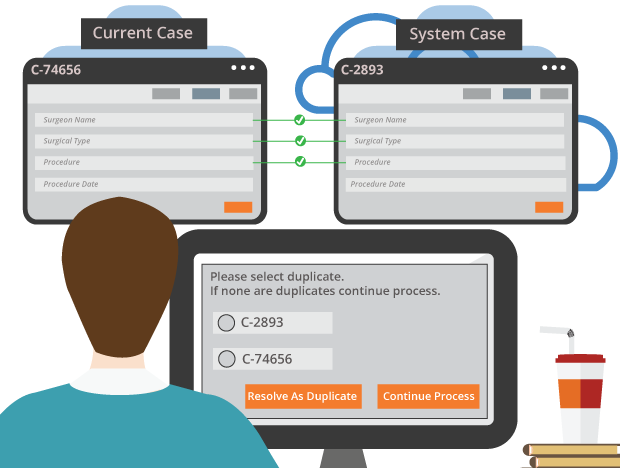
Duplicate cases
Duplicate cases
In many situations, a user may enter a case that has many of the same data values as another case already in the system. Usually, matching data is not an issue. For instance, two purchase requests may have the same request date, the same items, or the same customer name. However, if a specific combination of data values match, the new case is possibly a duplicate case.
For example, a health care services application processes requests to authorize insurance coverage for surgical procedures. A user enters a request for a specific surgeon to perform inpatient surgery on May 1 to repair a torn tendon. Two days later, the patient health care provider discovers that the surgeon is not available on the specified date. The provider submits a new request for the same type of surgery, the same surgeon, and the same procedure but for a procedure date of May 7. Because three of the four data values — the surgeon, type of surgery, and procedure — match in both requests, the second request is likely a duplicate. To avoid double-booking the procedure, the user should not process the request with the incorrect date. In these situations, users need to identify duplicate cases so that users can process the correct case.
Pega provides the search duplicate cases process to help users identify and resolve duplicate cases. This process is implemented in your case life cycle as a Search duplicate cases step. When a case enters the step, the system uses basic conditions and weighted conditions to compare specific property values with cases already present in the system. The system first evaluates the basic conditions to limit potential duplicates. All basic conditions must be met before considering potential duplicate cases. Once all basic conditions are met, the system continues to evaluate the weighted conditions to receive a weight value. Each condition has a weight (between 1 and 100) to determine the relative importance of a condition when making the comparisons. The system adds up the weights of all the conditions that evaluate to true. If the sum exceeds a specified threshold value, the system flags the current case as a potential duplicate. The search duplicate cases process then displays to the user the current case and the matching case in the system. The user may identify a potential duplicate from the list and resolve the current case as a duplicate. The system does not process the case further. The user may also decide that the current case is not a duplicate and may choose to continue processing the case.
In the previous example, assume that you have given the patient name as a basic condition and provided the surgeon name, surgery type, and date with a weighted condition of 25 each. The system displays the second request as a duplicate because the patient name, surgery type, surgeon name, and procedure match the values in an existing case. The total condition value is 75, exceeding a matching threshold of 50. The user decides that the second request is a duplicate and resolves the case as Resolved-Duplicate. The user then continues with the initial case and updates the procedure date.
